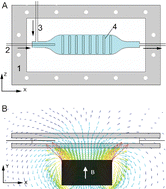Rapid detection of dengue virus in serum using magnetic separation and fluorescence detection
Abstract
A magnetophoretic fluorescence sensor (MFS) has been developed to rapidly detect dengue virus in serum at a sensitivity that was approximately three orders of magnitude higher than conventional solid phase immunoassays. UV inactivated type 2 dengue virus was first reacted with a mixture of superparamagnetic and fluorescent microparticles functionalised with an anti-type 2 dengue virus monoclonal antibody in 10% fetal calf serum. The magnetic particles were separated from the serum based on their magnetophoretic mobility, and dengue virus was detected by the co-localization of magnetic and fluorescent particles at a specific point in the flow chamber. The MFS was capable of detecting dengue-2 virus at 10 PFU ml−1 with a reaction time of 15 min. The MFS demonstrated a high specificity in the presence of yellow fever virus, a closely related flavivirus, which also did not produce any detectable increase in background signal. The improved performance of this technique appears to result from the rapid kinetics of the microparticle reaction, improved signal-to-noise ratio resulting from magnetophoretic separation, and rapid fluorescent particle detection. These results suggest that the MFS may be useful in early stage diagnosis of dengue infections, as well as other diseases.


 Please wait while we load your content...
Please wait while we load your content...